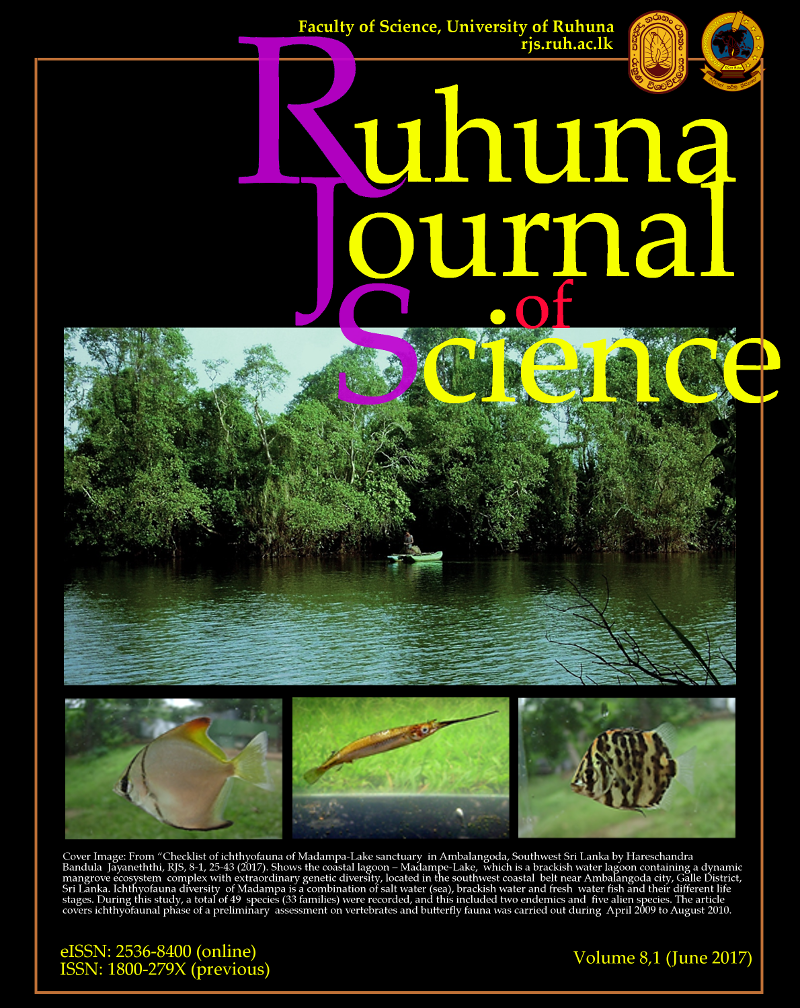Checklist of ichthyofauna of Madampa-Lake sanctuary in Ambalangoda, Southwest Sri Lanka
Abstract
Coastal lagoons provide unique services for many kinds of aquatic and semi aquatic organisms. Madampa-Lake is a brackish water lagoon containing a dynamic mangrove ecosystem complex with extraordinary genetic diversity, which is located in the southwest coastal belt near Ambalangoda city, Galle District. Very little literature is available on the Madampa-Lake’s fish and almost none of them have been published. A preliminary assessment on vertebrates and butterfly fauna was carried out during April 2009 to August 2010, and this article covers ichthyofaunal phase of the survey. Ichthyofauna diversity of Madampa is a combination of salt water (sea), brackish water and fresh water fish and their different life stages. During this study, a total of 49 species (33 families) were recorded, and this included two endemics and five alien species.Keywords. Brackish-water fauna, conservation, lagoons, mangrove-ecosystem, Sustainable uses.References
Bambaradeniya CNB, Ekanayake SP, Kekulandala LDCB, Fernando RHSS, Samarawickrama VAP, Priyadharshana TGM. 2002. An Assessment of the Status of Biodiversity in the Maduganga Mangrove Estuary. Occ. Pap. IUCN, Sri Lanka, 49 p.
Deraniyagala PEP. 1952. A coloured atlas of some vertebrates from Ceylon, fishes, National Museum, Colombo. 149pp.
Day F. 1889a. Fauna of British India, including Ceylon and Burma.Fishes.Vol. I. London, Taylor and Francis.548 pp.
Day F. 1889b. Fauna of British India, including Ceylon and Burma.Fishes. Vol. II. London, Taylor and Francis.509 pp.
De Silva M, Hapuarachchi N, Jayaratne T. 2015. Sri Lankan Freshwater fishers, Wildlife Conservation Society, Galle, Sri Lanka, 391pp.
Froese R, Pauly D. 2016. (Editors). FishBase. World Wide Web electronic publication.www.fishbase.org, version (06/2016)
Google earth V 6.2.2.6613. (February 19, 2014). Madampa-Lake. SIO, NOAA, U.S. Navy, NGA, GEBCO. TerraMetrics 2012, DigitalGlobe 2014. http://www.earth.google.com [April 26, 2012].
Jayaneththi HB. 2015. Record of Iridescent shark catfish Pangasianodon hypophthalmus Sauvage, 1878 (Siluriformes: Pangasiidae) from Madampa-Lake in Southwest Sri Lanka, Ruhuna Journal of Science, vol 6: 63-68.
Ministry of Environment National Redlist (MENR). 2012. The National Red List 2012 of Sri Lanka; Conservation Status of the Fauna and Flora. Ministry of Environment, Colombo, Sri Lanka. 476pp.
Murdy EO, Shibukawa K. 2003. A revision of the Indo-Pacific fish genus Caragobius (Gobiidae: Amblyopinae). Zootaxa 301: 1–12
Pethiyagoda R. 1991. Freshwater fishes of Sri Lanka. Wildlife Heritage Trust of Sri Lanka: Colombo. 362 pages + xiii.
Silva EIL, Katupotha J, Amarasinghe O, Manthrithilake H, Ariyaratna R. 2013. Lagoons of Sri Lanka: from the origins to the present. Colombo, Sri Lanka: International Water Management Institute, (IWMI). 122p. doi: 10.5337/2013.215
Sutherland WJ. 1996. Ecological Census Techniques: A Handbook. Cambridge University Press. Cambridge, UK. 336p.
The IUCN Red List of Threatened Species. Version 2016-3. . Downloaded on 22 December 2016.
Downloads
Published
Issue
Section
License
From Volume 7 (2016) onwards, all articles published in Ruhuna Journal of Science are Open Access articles published under the Creative Commons CC BY-NC 4.0 International License. This License permits use, distribution and reproduction in any medium, provided the original work is properly cited and is not used for commercial purposes.
Copyright on any research article published in RJS is retained by the respective author(s).
Authors who publish with this journal agree to the following terms:
a) Authors retain copyright and grant the journal right of first publication with the work simultaneously licensed under a Creative Commons Attribution License CC-BY-NC 4.0 International, that allows others to share the work with an acknowledgement of the work's authorship and initial publication in this journal.
b) Authors are able to enter into separate, additional contractual arrangements for the non-exclusive distribution of the journal's published version of the work (e.g., post it to an institutional repository or publish it in a book), with an acknowledgement of its initial publication in this journal.
c) Authors are permitted and encouraged to post their work online (e.g., in institutional repositories or on their website) prior to and during the submission process, as it can lead to productive exchanges, as well as earlier and greater citation of published work (See The Effect of Open Access).

